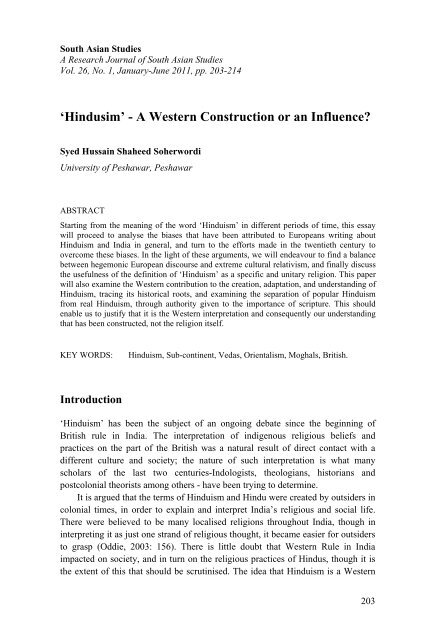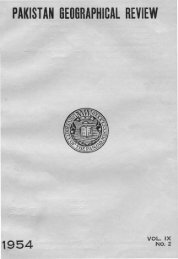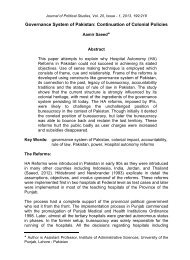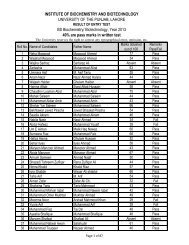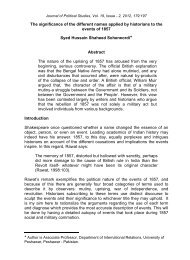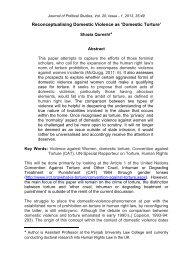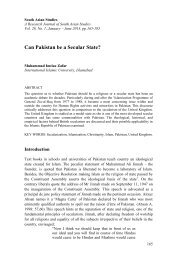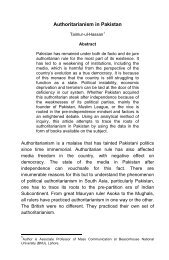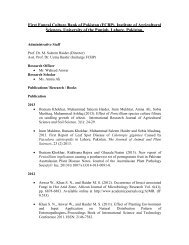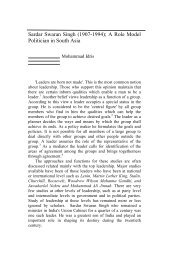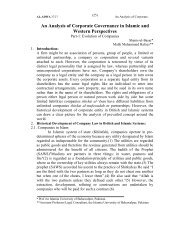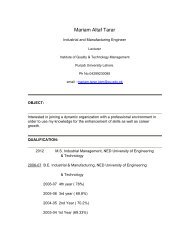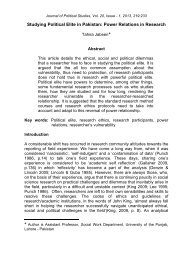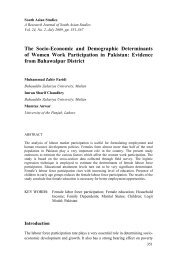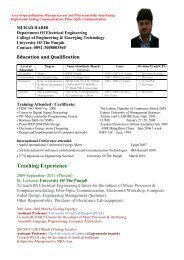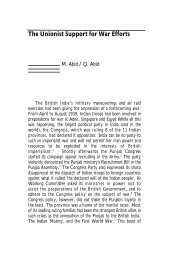'Hinduism'- A Western Construction or an Influence
'Hinduism'- A Western Construction or an Influence
'Hinduism'- A Western Construction or an Influence
Create successful ePaper yourself
Turn your PDF publications into a flip-book with our unique Google optimized e-Paper software.
South Asi<strong>an</strong> Studies<br />
A Research Journal of South Asi<strong>an</strong> Studies<br />
Vol. 26, No. 1, J<strong>an</strong>uary-June 2011, pp. 203-214<br />
‘Hindusim’ - A <strong>Western</strong> <strong>Construction</strong> <strong>or</strong> <strong>an</strong> <strong>Influence</strong>?<br />
Syed Hussain Shaheed Soherw<strong>or</strong>di<br />
University of Peshawar, Peshawar<br />
ABSTRACT<br />
Starting from the me<strong>an</strong>ing of the w<strong>or</strong>d ‘Hinduism’ in different periods of time, this essay<br />
will proceed to <strong>an</strong>alyse the biases that have been attributed to Europe<strong>an</strong>s writing about<br />
Hinduism <strong>an</strong>d India in general, <strong>an</strong>d turn to the eff<strong>or</strong>ts made in the twentieth century to<br />
overcome these biases. In the light of these arguments, we will endeavour to find a bal<strong>an</strong>ce<br />
between hegemonic Europe<strong>an</strong> discourse <strong>an</strong>d extreme cultural relativism, <strong>an</strong>d finally discuss<br />
the usefulness of the definition of ‘Hinduism’ as a specific <strong>an</strong>d unitary religion. This paper<br />
will also examine the <strong>Western</strong> contribution to the creation, adaptation, <strong>an</strong>d underst<strong>an</strong>ding of<br />
Hinduism, tracing its hist<strong>or</strong>ical roots, <strong>an</strong>d examining the separation of popular Hinduism<br />
from real Hinduism, through auth<strong>or</strong>ity given to the imp<strong>or</strong>t<strong>an</strong>ce of scripture. This should<br />
enable us to justify that it is the <strong>Western</strong> interpretation <strong>an</strong>d consequently our underst<strong>an</strong>ding<br />
that has been constructed, not the religion itself.<br />
KEY WORDS: Hinduism, Sub-continent, Vedas, Orientalism, Moghals, British.<br />
Introduction<br />
‘Hinduism’ has been the subject of <strong>an</strong> ongoing debate since the beginning of<br />
British rule in India. The interpretation of indigenous religious beliefs <strong>an</strong>d<br />
practices on the part of the British was a natural result of direct contact with a<br />
different culture <strong>an</strong>d society; the nature of such interpretation is what m<strong>an</strong>y<br />
scholars of the last two centuries-Indologists, theologi<strong>an</strong>s, hist<strong>or</strong>i<strong>an</strong>s <strong>an</strong>d<br />
postcolonial the<strong>or</strong>ists among others - have been trying to determine.<br />
It is argued that the terms of Hinduism <strong>an</strong>d Hindu were created by outsiders in<br />
colonial times, in <strong>or</strong>der to explain <strong>an</strong>d interpret India’s religious <strong>an</strong>d social life.<br />
There were believed to be m<strong>an</strong>y localised religions throughout India, though in<br />
interpreting it as just one str<strong>an</strong>d of religious thought, it became easier f<strong>or</strong> outsiders<br />
to grasp (Oddie, 2003: 156). There is little doubt that <strong>Western</strong> Rule in India<br />
impacted on society, <strong>an</strong>d in turn on the religious practices of Hindus, though it is<br />
the extent of this that should be scrutinised. The idea that Hinduism is a <strong>Western</strong><br />
203
South Asi<strong>an</strong> Studies 26 (1)<br />
construction would imply it as being created as <strong>an</strong> ideology, as opposed to <strong>an</strong><br />
impartially interpreted <strong>an</strong>cient religion.<br />
In fact, interpretations may vary acc<strong>or</strong>ding to different systems of<br />
classification, <strong>an</strong>d the argument that m<strong>an</strong>y scholars have recently supp<strong>or</strong>ted is that<br />
the Europe<strong>an</strong> rendering of Indi<strong>an</strong> civilisation – including religion - is <strong>an</strong><br />
intrinsically biased one. However, at the same time, it is difficult to imagine a truly<br />
‘neutral’ point of view in the treatment of <strong>an</strong>y cultural issue.<br />
‘Hinduism’: Origins of the W<strong>or</strong>d <strong>an</strong>d Ch<strong>an</strong>ges in Me<strong>an</strong>ing<br />
It is first necessary to establish that Hinduism, despite its uniqueness, is a religion<br />
in its own right, as opposed to being a collection of ideas, <strong>or</strong> a <strong>Western</strong> creation.<br />
Religion c<strong>an</strong> be categ<strong>or</strong>ised into two main models; the river <strong>an</strong>d the arb<strong>or</strong>eal<br />
model (Flood, 1996: 16). The river model states that there are m<strong>an</strong>y streams of<br />
belief which all flow into one main religion, whilst the arb<strong>or</strong>eal model is the exact<br />
inverse, having several traditions br<strong>an</strong>ching from main belief system. Christi<strong>an</strong>ity<br />
c<strong>an</strong> be seen as fitting into the latter, whilst Hinduism is closest to the River model.<br />
It is a vague interpretation however, <strong>an</strong>d would be m<strong>or</strong>e accurately described as a<br />
number of quite distinctive rivers. On this alone, it is possible to segregate<br />
Hinduism from other w<strong>or</strong>ld religions, which is why some have argued its religious<br />
foundations dubious. A striking feature is that it is polytheistic, me<strong>an</strong>ing there is<br />
no single founder as there is with Christi<strong>an</strong>ity <strong>an</strong>d Islam, making a unified system<br />
difficult to construct. It is also defined by othopraxy as opposed to <strong>or</strong>thodoxy;<br />
focussing on practice not belief. The structure of Hinduism is distinctive in the fact<br />
that focus on the social aspect of is key. This does not however me<strong>an</strong> that<br />
Hinduism c<strong>an</strong>not be deemed as a religion. Emile Durkheim’s definition of religion<br />
as “a unified set of beliefs <strong>an</strong>d practices relative to sacred things which creates a<br />
social bond between people” (Flood, 1996: 9) is extremely fitting with regards to<br />
Hinduism. This is also true of Jawaharlal Nehru’s, the first prime minister of<br />
independent India, interpretation, when he described Hinduism as being “all<br />
things to men”. Fuller (1996) argues that Hinduism should not be thought of as a<br />
tradition, indigenous categ<strong>or</strong>y, <strong>or</strong> concept, but as religion founded on structured<br />
relationships <strong>an</strong>d as coherent <strong>an</strong>d distinctive. Those within religion, put emphasis<br />
on m<strong>or</strong>e th<strong>an</strong> just the deities <strong>an</strong>d their comm<strong>an</strong>ds, <strong>an</strong>d focus on social customs,<br />
<strong>an</strong>d separate w<strong>or</strong>ship group. Spear, highlights the ambiguity of Hinduism by<br />
likening it “ to a vast sponge, which abs<strong>or</strong>bs all that enters it without ceasing to<br />
be itself…like a sponge it has no very clear outline on its b<strong>or</strong>ders <strong>an</strong>d no apparent<br />
c<strong>or</strong>e at its centre” (Inden, 1990: 85). Theref<strong>or</strong>e, although Hinduism may be vague<br />
in f<strong>or</strong>m, its centrality to Indi<strong>an</strong> society should be stressed to emphasis it as a<br />
religion. So whilst we c<strong>an</strong> establish it as a religion, it is necessary to examine its<br />
hist<strong>or</strong>y, in <strong>or</strong>der to establish the extent of <strong>Western</strong> influence <strong>an</strong>d construction<br />
through their interpretation.<br />
204
Syed Hussain Shaheed Soherw<strong>or</strong>di ‘Hinduism’-A <strong>Western</strong><br />
The term Hindu is Persi<strong>an</strong> f<strong>or</strong> the river Indus, which is derived from Sindu,<br />
making it noticeably the only w<strong>or</strong>ld religion (aside from Judaism) to be named<br />
after a place, as opposed to a founder <strong>or</strong> doctrine (Inden, 1990: 85). It was first<br />
used by the Persi<strong>an</strong>s to designate both the river <strong>an</strong>d its valley, <strong>an</strong>d consequently<br />
came to indicate the indigenous people of that area. It was in the 17 th century that<br />
the term ‘Hindu’ was first used in the English l<strong>an</strong>guage. There is some<br />
disparagement as to whether it was used to refer to those of indigenous religion,<br />
excluding the Islamic faith <strong>or</strong> whether, as Flood (1996: 5) argues, that it was in<br />
reference to Indi<strong>an</strong>s of <strong>an</strong>y religion. Regardless, it wasn’t until the 19 th century<br />
(1830) that those known as Hindu were classed as part of the religion of<br />
“Hinduism” (Flood, 1996: 8). It is interesting to note that <strong>an</strong> “ism”, is almost<br />
always used to denote to <strong>an</strong> ideology <strong>or</strong> philosophy, as opposed to a religion, <strong>an</strong>d<br />
may here be interpreted as a <strong>Western</strong> modernisation. The British then refocused<br />
their ideas of Hinduism to refer to the Brahmins within high caste who followed<br />
the teachings of the dharma within the <strong>an</strong>cient S<strong>an</strong>skrit texts. Whilst the British<br />
were defining <strong>an</strong>d redefining the term Hinduism with regards to their<br />
underst<strong>an</strong>ding of it, it shouldn’t be overlooked that Hindus had <strong>an</strong> awareness of<br />
the term Hindu themselves; there is reference in S<strong>an</strong>skrit <strong>an</strong>d Bengali scripture as<br />
early as the 1500 (Oddie, 2003: 161) .<br />
It is imp<strong>or</strong>t<strong>an</strong>t to stress that there was a definite consciousness within society<br />
of being Hindu during pre colonial times. Bef<strong>or</strong>e the Moghuls reached India, in<br />
1000AD, there was no unified sense of religion, but a fragmented belief system of<br />
m<strong>an</strong>y diverse str<strong>an</strong>ds with localised practices <strong>an</strong>d rituals. After the first Muslim<br />
invasions, the w<strong>or</strong>d was used to distinguish the indigenous masses of the Indi<strong>an</strong><br />
subcontinent from the new conquer<strong>or</strong>s. The geographical connotations of the w<strong>or</strong>d<br />
‘Hindu’ were thus overcome by a new, broader me<strong>an</strong>ing – it came to encompass<br />
the whole of the native culture, as opposed to that of the Muslims. When Islamic<br />
rule beg<strong>an</strong>, the first signs of unification became apparent, as a distinction of us <strong>an</strong>d<br />
them, insiders <strong>an</strong>d f<strong>or</strong>eigners, beg<strong>an</strong> to be made (Oddie, 2003: 159). The<br />
differences were not just found in religious practice but also in terms of social<br />
behaviour <strong>or</strong>g<strong>an</strong>isation, l<strong>an</strong>guage, dress, <strong>an</strong>d housing. The differences acted as a<br />
unifying device f<strong>or</strong> those who were native to India. It was in the 16 th <strong>an</strong>d 17 th<br />
century when Shivaji, the founder of the Martha Empire, was in conflict with the<br />
Moghuls, that Hindus were first rec<strong>or</strong>ded as referring to themselves as such, <strong>an</strong>d<br />
religious awareness beg<strong>an</strong> to spread. The new me<strong>an</strong>ing was brought further in the<br />
eighteenth century by the British, who assuming the unity of ‘Hindu culture’<br />
started to study one of its most obvious expressions, religion, as a whole – hence<br />
the w<strong>or</strong>d ‘Hinduism’ was invented to designate the ‘religion of the Hindus’<br />
(Oddie, 2003: 156).<br />
205
South Asi<strong>an</strong> Studies 26 (1)<br />
The ‘Unity’ <strong>an</strong>d ‘Essence’ of Religion<br />
Indi<strong>an</strong> religion was thus perceived as a unity by outsiders. This led to a search on<br />
the part of the British f<strong>or</strong> <strong>an</strong> encompassing ‘system’ that would make sense of the<br />
whole ensemble of religious beliefs, practices <strong>an</strong>d philosophies that were held to<br />
be part of it. This idea came from the Christi<strong>an</strong> conception of religion, i.e. <strong>an</strong><br />
<strong>or</strong>g<strong>an</strong>ic <strong>an</strong>d homogeneous system based on a few sacred written texts, with a fix<br />
set of beliefs <strong>an</strong>d one God as the object of devotion, allowing f<strong>or</strong> but little<br />
variation.<br />
The Vedas <strong>an</strong>d other <strong>an</strong>cient texts were thus considered by Europe<strong>an</strong>s to be<br />
the Hindu ‘Bible’; the social division in castes became the ‘essence’ of religion,<br />
together with the idea of Brahm<strong>an</strong> as the only God, while all the other deities were<br />
regarded as mere expressions of His different features (also including ideas of<br />
Trinity); the popular m<strong>an</strong>ifestations of faith were classified as ‘superstition’, in<br />
contrast with the liturgical rituals of the Brahmins (Marshall, 1970: 24-27).<br />
The first Europe<strong>an</strong>s to write accounts of India thus relied on their own<br />
categ<strong>or</strong>ies rather th<strong>an</strong> Indi<strong>an</strong> ones to represent Hinduism; one might argue that in<br />
<strong>or</strong>der to make <strong>an</strong> unknown culture comprehensible to Europe, it was perhaps m<strong>or</strong>e<br />
‘natural’ <strong>an</strong>d certainly easier f<strong>or</strong> missionaries <strong>an</strong>d Indologists to use their own<br />
system of classification in describing new concepts <strong>an</strong>d ideas.<br />
However, looking at Hinduism m<strong>or</strong>e closely, we realise that it is actually very<br />
different from what eighteenth <strong>an</strong>d nineteenth century writers described it to be.<br />
While the Vedas are central f<strong>or</strong> m<strong>an</strong>y Hindus, others reject their auth<strong>or</strong>ity;<br />
monotheism, polytheism, <strong>an</strong>imism <strong>or</strong> even a s<strong>or</strong>t of atheism st<strong>an</strong>d side by side,<br />
together with very different ideas of cosmogony; the concepts of karma <strong>an</strong>d<br />
rebirth, which some scholars sustained to be <strong>an</strong> underlying feature of Hinduism,<br />
are not in fact shared among all Hindus; the principle of non-violence (ahimsa)<br />
coexists with blood ritual; ascetism with sexual metaph<strong>or</strong>s; etc. In fact, it seems<br />
impossible to find even one single belief, value <strong>or</strong> ritual common to all Hindus<br />
(von Stietencron, 1989: 14).<br />
Considering these variations, regarding not only f<strong>or</strong>mal expressions of<br />
devotion but also fundamental traits that n<strong>or</strong>mally distinguish one religion from<br />
<strong>an</strong>other, the fact that Europe<strong>an</strong>s regarded Hinduism as ‘irrational’ – as we will see<br />
– is hardly surprising. Its irrationality, however, seems to derive m<strong>or</strong>e from the<br />
imposition of <strong>Western</strong> categ<strong>or</strong>ies upon Indi<strong>an</strong> religion, rather th<strong>an</strong> being intrinsic<br />
to ‘Hinduism’ itself.<br />
The British Entry into the Subcontinent <strong>an</strong>d its Effects on<br />
‘Hinduism’<br />
It was when the British, East Indi<strong>an</strong> Trading Comp<strong>an</strong>y took over power from the<br />
Moghuls in 1857 that the <strong>Western</strong> construction of Hinduism, allegedly<br />
commenced. It was the Trading Comp<strong>an</strong>y, not the British Crown who held power<br />
206
Syed Hussain Shaheed Soherw<strong>or</strong>di ‘Hinduism’-A <strong>Western</strong><br />
in India, until 1859 when rule was tr<strong>an</strong>sferred. The Trading Comp<strong>an</strong>y attempted to<br />
concern themselves chiefly with the wealth <strong>an</strong>d economy of the country <strong>an</strong>d<br />
dist<strong>an</strong>ce themselves from matters of politics. It was decided that to maintain power<br />
<strong>an</strong>d prevent <strong>an</strong>y potential uprising, they should govern Indi<strong>an</strong> people with their<br />
own laws <strong>an</strong>d beliefs in terms of domestic rule. It is this period that is thought of<br />
as a maj<strong>or</strong> turning point in the development of Hinduism. Oriental scholars were<br />
employed to tr<strong>an</strong>slate the <strong>an</strong>cient S<strong>an</strong>skrit texts of the Brahmins into English, in<br />
<strong>or</strong>der to rule with it. The scriptures however proved very difficult to tr<strong>an</strong>slate,<br />
especially from a neutral non ethnocentric st<strong>an</strong>d point. Alex<strong>an</strong>der Dow was one of<br />
the leading scholars of the tr<strong>an</strong>slation of the scriptures (Marshall, 1970: 3).<br />
S<strong>an</strong>skrit was completely f<strong>or</strong>eign to <strong>Western</strong> scholars so it was necessary f<strong>or</strong> highcaste<br />
Brahmins to first tr<strong>an</strong>slate the S<strong>an</strong>skrit to Persi<strong>an</strong>, <strong>an</strong>d from this tr<strong>an</strong>slated it<br />
into English. It was then codified by Dow in <strong>or</strong>der to assist with future<br />
tr<strong>an</strong>slations. The complication of the tr<strong>an</strong>slations me<strong>an</strong>t scholars struggled to resist<br />
projecting their own Christi<strong>an</strong> beliefs onto Hindu law. However to sight Hinduism<br />
as the construction of <strong>Western</strong> thought, is King (1999) believes a little flattering;<br />
the contributions of the Bengal scholars <strong>an</strong>d Brahmins should not be overlooked.<br />
Pri<strong>or</strong> to the tr<strong>an</strong>slation, the scriptures were only available to the highest caste,<br />
the Brahmins, the British however made them openly available to everyone. There<br />
is much argument surrounding this point, with the British accused of<br />
overemphasising the text as key to everyday Hindu practices. It has since been<br />
argued that the ideas were focussed too heavily on the model of Christi<strong>an</strong>ity, in<br />
regards to the role the Bible plays. At the time Christi<strong>an</strong>ity was considered the<br />
purest f<strong>or</strong>m of religion by the West, leading to non-existent parallels with structure<br />
<strong>an</strong>d the centrality of text, being made. However it became apparent that as the vast<br />
maj<strong>or</strong>ity of Hindus were illiterate they did not in fact follow the texts at all relying<br />
on <strong>or</strong>al <strong>an</strong>d visual tradition instead. Despite this, scholars did not fact<strong>or</strong> this into<br />
their interpretation of Hinduism. In <strong>or</strong>der to explain it away, they made the<br />
distinction of real Hinduism <strong>an</strong>d popular Hinduism with the latter often dismissed<br />
as no m<strong>or</strong>e th<strong>an</strong> superstition.<br />
Regardless of this interpretation, it is apparent that within the texts there are<br />
large sections missing on key parts of Hindu belief such as Brahm<strong>an</strong>hood <strong>an</strong>d<br />
Untouchability. The scriptures tend to focus m<strong>or</strong>e on l<strong>an</strong>d ownership <strong>an</strong>d food <strong>an</strong>d<br />
gift exch<strong>an</strong>ge, <strong>an</strong>d whilst the Vedas do contain large amounts of sutras, the Grihya<br />
rituals (which are domestic rites concerned with sacrifice) are noticeably missing<br />
(Das, 1977: 2). They are depend<strong>an</strong>t on popular tradition, being passed through<br />
society via m<strong>or</strong>e simplistic methods such as <strong>or</strong>al traditions. Due to the fact that a<br />
large prop<strong>or</strong>tion of citizens were illiterate, Indologists tried to argue that true<br />
Hinduism b<strong>or</strong>e little relev<strong>an</strong>ce to them, with the foundations of their beliefs no<br />
m<strong>or</strong>e th<strong>an</strong> mere folkl<strong>or</strong>e. Srinivas (Das, 1977: 5) however stresses that<br />
“Distinction between S<strong>an</strong>skritic <strong>an</strong>d non-s<strong>an</strong>skritic Hinduism also existed outside<br />
the S<strong>an</strong>skritic texts”, implying the difference as m<strong>or</strong>e structure <strong>an</strong>d interpretation<br />
based. M<strong>an</strong>y of the scriptures such as the Dharmar<strong>an</strong>ya Pur<strong>an</strong>a, are myth centred,<br />
207
South Asi<strong>an</strong> Studies 26 (1)<br />
with the myths of creation including, the creation of Dharmar<strong>an</strong>ya, <strong>an</strong>d the<br />
creation of V<strong>an</strong>ikas are presented, <strong>an</strong>d taken to be empirical fact. French<br />
<strong>an</strong>thropologist Levi-Strauss (Das, 1977: 16) however warned against scholars<br />
doing this, arguing “myth is certainly related to given [empirical] facts, but not as<br />
a representation of them”. So whilst the British were successful at discovering the<br />
laws f<strong>or</strong> certain domestic rites, such as inherit<strong>an</strong>ce <strong>an</strong>d marriage, they failed to<br />
interpret the practices relev<strong>an</strong>t to everyday Hindu life, as applicable to their rule.<br />
From this it is apparent that the <strong>Western</strong> scholars were never able to reach the<br />
crux of the true me<strong>an</strong>ing of Hinduism. Hinduism was always seen as the “Other”<br />
(Flood, 1996: 8) in reference to Christi<strong>an</strong>ity, not as a real religion in its own right<br />
by scholars. This is connected to the practices <strong>an</strong>d beliefs such as samsara <strong>an</strong>d<br />
karma, which were completely alien to British thought at the time. In <strong>or</strong>der to<br />
underst<strong>an</strong>d the teachings, interpretation had to be based on something they were<br />
familiar with, namely the Christi<strong>an</strong> religion. The scholars Jones <strong>an</strong>d Halhed used<br />
the Christi<strong>an</strong> idea that all men are descend<strong>an</strong>ts of Noah, <strong>an</strong>d undertook the task of<br />
proving similarities within race <strong>an</strong>d linguistic f<strong>or</strong>m of the Europe<strong>an</strong>s <strong>an</strong>d the<br />
Indi<strong>an</strong>s (Marshall, 1970). It c<strong>an</strong> be argued that the beliefs, practices <strong>an</strong>d doctrines,<br />
do show some similarity in their application, though Jones <strong>an</strong>d Halhed, refute this,<br />
claiming there is maj<strong>or</strong> disparity between the east <strong>an</strong>d west, arguing Hinduism as<br />
“inherently backwards” (Marshall, 1970: 20). Further research into the S<strong>an</strong>skrit<br />
scriptures attempted to prove that there were linguistic similarities to Latin <strong>an</strong>d<br />
Greek. However there was never <strong>an</strong>y real scientific proof f<strong>or</strong> this stream of<br />
thought. Je<strong>an</strong> Bouchet tried to create links between Hinduism <strong>an</strong>d Christi<strong>an</strong>ity in<br />
arguing there are “resembl<strong>an</strong>ces between Abraham <strong>an</strong>d Brahm<strong>an</strong>, <strong>an</strong>d Krishna<br />
<strong>an</strong>d Moses, as well as the Hindus’ confused idea of the trinity” (Marshall, 1970:<br />
24). The contemp<strong>or</strong>aries of Jones <strong>an</strong>d Halhed, Holwell <strong>an</strong>d Dow however,<br />
disputed these similarities arguing that the belief system of Hinduism had been<br />
long established bef<strong>or</strong>e Christi<strong>an</strong>ity. The fact that <strong>Western</strong> thought attempted to<br />
rationalise Hindu practice through Christi<strong>an</strong>ity, shows that it was well established<br />
pri<strong>or</strong> to British rule. Ronald Inden was highly critical of the arrog<strong>an</strong>ce of <strong>Western</strong><br />
scholarship, criticising the western interpretation as nothing m<strong>or</strong>e th<strong>an</strong><br />
“epistemological assumptions <strong>an</strong>d political biases” (Flood, 1996: 19). Towards<br />
the end of the 18 th century the attitude of Europe<strong>an</strong>s towards Hinduism, was that of<br />
disgust <strong>an</strong>d ridicule. The Europe<strong>an</strong> thought process could simply not comprehend<br />
the idea of multiple deities; seeing “repellent images <strong>an</strong>d barbarous customs”<br />
(Marshall, 1970: 20). It wasn’t until the end of the 19 th century attitudes shifted to<br />
become m<strong>or</strong>e toler<strong>an</strong>t.<br />
This was partly due to the influence of missionaries within India, who<br />
attempted religious harmony, whilst spreading the message of Christi<strong>an</strong>ity.<br />
Though the true essence of Hinduism was repeatedly misinterpreted, it is<br />
imp<strong>or</strong>t<strong>an</strong>t to see how British rule <strong>an</strong>d Christi<strong>an</strong> missionaries did impact on the<br />
awareness of being Hindu. M<strong>an</strong>y of the British laws enf<strong>or</strong>ced, such as the b<strong>an</strong>ning<br />
of inf<strong>an</strong>ticide, hum<strong>an</strong> sacrifice, <strong>an</strong>d most notable Sati, all contributed to<br />
208
Syed Hussain Shaheed Soherw<strong>or</strong>di ‘Hinduism’-A <strong>Western</strong><br />
ref<strong>or</strong>mulation of tradition. The practice of Sati, widow burning, was outlawed in<br />
1829, <strong>an</strong>d caused maj<strong>or</strong> protest. Hindus argued that the practice was in their<br />
scriptures, <strong>an</strong>d theref<strong>or</strong>e their right; the British however viewed it as barbaric <strong>an</strong>d<br />
<strong>an</strong> infringement on women rights. The practice itself was not particularly<br />
widespread, though with the prohibition, numbers increased as a f<strong>or</strong>m of protest<br />
(M<strong>an</strong>i, 1990). Though it was unintentional, the actions of the British f<strong>or</strong>ced a<br />
sense of community <strong>an</strong>d unity that had not been apparent bef<strong>or</strong>e, with large<br />
numbers of Hindus mobilised in attempt to protect their traditions (Oddie, 2003:<br />
171). Missionaries were also influential through the mass-conversions of over<br />
300,000 Hindus, to the Christi<strong>an</strong> religion. Ultimately this me<strong>an</strong>t that those of<br />
Hindu practice beg<strong>an</strong> to inc<strong>or</strong>p<strong>or</strong>ate Christi<strong>an</strong> ideals, though at the same time it<br />
also created further unification of Hindus propelling them together in a sense of<br />
self defence.<br />
The ‘Adoption’ of the Hindu Identity<br />
If Hinduism is a Europe<strong>an</strong> misconstruction, one might wonder why those who are<br />
referred to as ‘Hindus’, <strong>an</strong>d who did not recognise themselves as such bef<strong>or</strong>e the<br />
arrival of f<strong>or</strong>eign rulers, did not reject this term.<br />
The coming into contact with Europe<strong>an</strong> culture caused cultural <strong>an</strong>d religious<br />
matters to gain political value, provoking a greater sense of unity among Indi<strong>an</strong>s.<br />
This happened f<strong>or</strong> various reasons. First of all, the differences between the<br />
dominat<strong>or</strong>s <strong>an</strong>d the subjects were greater th<strong>an</strong> those among Indi<strong>an</strong>s themselves - in<br />
fact, this also applied to the Muslim invasions, <strong>an</strong>d it was as a consequence of this<br />
that Hindus in the sixteenth <strong>an</strong>d seventeenth centuries beg<strong>an</strong> to call themselves by<br />
that name (Oddie, 2003: 160).<br />
Another fact<strong>or</strong> involved was the spread of the English l<strong>an</strong>guage in India,<br />
which caused Indi<strong>an</strong>s to adopt English terminology <strong>an</strong>d some of the<br />
preconceptions inherently present within it (Oddie, 2003: 162).<br />
On the m<strong>or</strong>e strictly political side, the British interference with Indi<strong>an</strong><br />
religious practices was of great imp<strong>or</strong>t<strong>an</strong>ce, especially since the colonial rule had<br />
always promised a policy of non-interference with Indi<strong>an</strong> culture <strong>an</strong>d society. The<br />
b<strong>an</strong>ning of sati (‘widow burning’ on her husb<strong>an</strong>d’s pyre) in 1829, which caused<br />
great alarm <strong>an</strong>d the Christi<strong>an</strong>-biased government of Madras by L<strong>or</strong>d Tweeddale<br />
(1842-48) that provoked riots <strong>an</strong>d mobs against Christi<strong>an</strong> villages are only two of<br />
m<strong>an</strong>y examples (Oddie, 2003: 169-171).<br />
Restrictive measures such as these gave <strong>or</strong>igin to a deep division between the<br />
colonial rulers <strong>an</strong>d their subjects, who came together in <strong>or</strong>der to contrast British<br />
interference (e.g., through actions that r<strong>an</strong>ged from petitions in favour of sati to<br />
the creation of Hindu ‘missionary’ associations, <strong>an</strong>d, in m<strong>or</strong>e extreme cases, to<br />
riots <strong>an</strong>d mutinies such as those of 1857) (ibid.).<br />
M<strong>an</strong>y Indi<strong>an</strong>s thus started to adopt a communal ‘Hindu’ identity; a fact that<br />
was caused by these <strong>an</strong>d other fact<strong>or</strong>s, including, ironically, the influence of<br />
209
South Asi<strong>an</strong> Studies 26 (1)<br />
Christi<strong>an</strong> ideas (e.g. a sense of community, ideas such as “love thy neighbour”,<br />
etc.) on Indi<strong>an</strong> subjects (Oddie, 2003: 178).<br />
Orientalist Discourse<br />
The accept<strong>an</strong>ce of the concept of Hinduism on the part of ‘Hindus’ consolidated<br />
its reification in what Edward Said calls ‘Orientalist discourse’. In his most<br />
influential w<strong>or</strong>k, Orientalism (1978), Said argues that Europe<strong>an</strong>s writing about<br />
Middle-Eastern <strong>an</strong>d Asiatic countries have created a specific discourse that<br />
produced a stereotypical <strong>an</strong>d dist<strong>or</strong>ted representation of the ‘Orient’. (In fact, this<br />
also applies to the visual arts: m<strong>an</strong>y Orientalist paintings were produced in the<br />
nineteenth century, often by painters who had not even visited the countries they<br />
were depicting). Such representation constructed a structural opposition between<br />
the male, rational, superi<strong>or</strong> West <strong>an</strong>d the female, imaginative <strong>an</strong>d inferi<strong>or</strong> East.<br />
Hinduism was hence represented as <strong>an</strong> irrational religion, often compared to a<br />
jungle, in contrast to the rational <strong>an</strong>d <strong>or</strong>dered idea of Christi<strong>an</strong>ity (Inden, 1990: 86-<br />
87).<br />
Although some early writers explicitly claimed the inferi<strong>or</strong>ity of Oriental<br />
cultures, this bias, Said argues, has remained implicit in discourse to the present<br />
day, causing scholars to unconsciously reproduce this misrepresentation. Said<br />
writes:<br />
“The things to look at are style, figures of speech, setting,<br />
narrative devices, hist<strong>or</strong>ical <strong>an</strong>d social circumst<strong>an</strong>ces, not the<br />
c<strong>or</strong>rectness of the representation n<strong>or</strong> its fidelity to some great<br />
<strong>or</strong>iginal. (...) I believe it needs to be made clear about cultural<br />
discourse <strong>an</strong>d exch<strong>an</strong>ge within a culture that what is<br />
commonly circulated by it is not ‘truth’ but representations”<br />
(Leitch et al. (ed.), 2001: 2007).<br />
Hence we c<strong>an</strong> also point out that although we have generally referred to a<br />
‘<strong>Western</strong>’ reification of Hinduism, this construction br<strong>an</strong>ches out in a few<br />
different (but strongly interrelated) ‘sub-constructions’, as representations vary<br />
acc<strong>or</strong>ding to the social, hist<strong>or</strong>ical, <strong>an</strong>d cultural background of who makes them.<br />
We will thus go on to <strong>an</strong>alyse the main constructions of Hinduism produced by the<br />
West.<br />
Utilitari<strong>an</strong> <strong>an</strong>d Evolutionist Representations<br />
The materialist, secular point of view that characterised utilitari<strong>an</strong> thought<br />
invariably led to the interpretation of Hindu attention to ritual as the symptom of a<br />
lower level of evolution. Utilitari<strong>an</strong>s considered reverential <strong>an</strong>d ceremonial<br />
conduct as the opposite of practical, ‘useful’ <strong>an</strong>d rational conduct (Inden, 1986:<br />
210
Syed Hussain Shaheed Soherw<strong>or</strong>di ‘Hinduism’-A <strong>Western</strong><br />
418). James Mill’s Hist<strong>or</strong>y of British India (1858) describes Hindu cosmology as<br />
dis<strong>or</strong>dered <strong>an</strong>d def<strong>or</strong>med <strong>an</strong>d Hinduism in general as pervaded by “folly” <strong>an</strong>d<br />
“absurdity” (Inden, 1990: 91-92).<br />
The discovery that the Vedas were produced earlier th<strong>an</strong> the Bible gave<br />
<strong>or</strong>igin to the idea that they were the oldest religious texts of the Ary<strong>an</strong>s (including<br />
both Europe<strong>an</strong>s <strong>an</strong>d Indi<strong>an</strong>s); hence, from the study of Brahmin ritual (which is<br />
based on the Vedas), it was possible to underst<strong>an</strong>d “the religion of m<strong>an</strong> (...) at his<br />
moment of <strong>or</strong>igin” (Inden 1990: 98). This developed in the evolutionist idea that<br />
Hinduism was the religion of hum<strong>an</strong>ity at a less developed stage th<strong>an</strong> that of<br />
<strong>Western</strong> civilisation, which had reached the top of the evolutionary scale with<br />
Christi<strong>an</strong>ity.<br />
Idealistic, Rom<strong>an</strong>tic <strong>an</strong>d Psycho<strong>an</strong>alytic Interpretations<br />
Hegel, the eighteenth-century Germ<strong>an</strong> philosopher, spread the idea of <strong>an</strong> India<br />
dominated by imagination in two of his w<strong>or</strong>ks, The Philosophy of Hist<strong>or</strong>y <strong>an</strong>d The<br />
Philosophy of Mind. He classified reason <strong>or</strong> underst<strong>an</strong>ding (Verst<strong>an</strong>d), as the<br />
highest, spiritual faculty, <strong>an</strong>d representation (V<strong>or</strong>stellung) <strong>an</strong>d ‘creative<br />
imagination’ (Ph<strong>an</strong>tasie) as the lower faculties dealing with the material w<strong>or</strong>ld <strong>an</strong>d<br />
passions. While the f<strong>or</strong>mer was, ‘naturally’, associated with the West, Hegel held<br />
that India’s Geist (i.e. its ‘spirit’) was dominated by Imagination. Hence came the<br />
expl<strong>an</strong>ation f<strong>or</strong> Hinduism’s contradicting <strong>an</strong>d irrational features, e.g. the<br />
coexistence of <strong>an</strong> extreme Brahmin rituality with a pervasive mysticism in<br />
‘popular’ Hinduism (Inden, 1990: 94-96).<br />
Hegel also argued that in the spiritual development of hum<strong>an</strong>kind, India had<br />
the same characteristics as the mental condition of a person sleeping just bef<strong>or</strong>e<br />
waking up (Inden, 1990: 96); a view that was also adopted by Rom<strong>an</strong>tic <strong>an</strong>d<br />
psycho<strong>an</strong>alytical the<strong>or</strong>ists.<br />
Germ<strong>an</strong> Rom<strong>an</strong>ticism exalted the ‘irrationality’ <strong>an</strong>d Imagination that Hegel,<br />
the utilitari<strong>an</strong>s <strong>an</strong>d other representatives of the Enlightenment considered as the<br />
reasons f<strong>or</strong> India’s inferi<strong>or</strong>ity. Rom<strong>an</strong>tic philosophy, in fact, denied the existence<br />
of <strong>an</strong> abstract, all-encompassing Reason, arguing that both rationality <strong>an</strong>d<br />
emotions were essential f<strong>or</strong> the contemplation of the Sublime. Hence mysticism<br />
<strong>an</strong>d the search f<strong>or</strong> self-disintegration in <strong>an</strong> impersonal Brahm<strong>an</strong> were highly<br />
thought of among the Rom<strong>an</strong>tics. Nevertheless, India came to represent, in their<br />
view, a l<strong>an</strong>d characterised by the uncontrolled predomin<strong>an</strong>ce of Imagination, just<br />
as the West represented rationality taken to the extreme (Inden, 1990: 93).<br />
The view that Indi<strong>an</strong> civilisation was pervaded by imagination <strong>an</strong>d the<br />
metaph<strong>or</strong> of the dream were also supp<strong>or</strong>ted by Jungi<strong>an</strong>s. In fact, they visualised<br />
the West as c<strong>or</strong>responding to the conscious stratum of the hum<strong>an</strong> mind, while the<br />
East represented the unconscious one (Inden, 1990: 123). In <strong>an</strong>alysing Louis<br />
Renou’s account of Brahmin rituals in Religions of Ancient India, Inden (1986)<br />
has also highlighted the Freudi<strong>an</strong> interpretation of Indi<strong>an</strong> religion by Indologists.<br />
211
South Asi<strong>an</strong> Studies 26 (1)<br />
In The interpretation of dreams, Freud outlines the main features of dreams;<br />
namely, ‘condensation’ (the repetition of elements), ‘displacement’ (which makes<br />
imp<strong>or</strong>t<strong>an</strong>t things seem irrelev<strong>an</strong>t <strong>an</strong>d vice versa), <strong>an</strong>d ‘secondary revision’ (which<br />
provides the irrational nature of dreams with a rational façade). Inden shows how<br />
Renou describes Vedic rituals as being characterised by both condensation <strong>an</strong>d<br />
displacement, while he himself, as the ‘rational Europe<strong>an</strong>’, takes the task of<br />
providing a secondary revision to make sense of the ‘irrational’ ritual actions<br />
(Inden, 1986: 411-414).<br />
Structuralist Analysis <strong>an</strong>d the Search f<strong>or</strong> <strong>an</strong> Indi<strong>an</strong><br />
‘Ethnosociology’<br />
In the twentieth century, structuralists introduced a different – one could say,<br />
almost revolutionary - conception of Hinduism, based on the assumption that it<br />
possesses <strong>an</strong> inherent rationality. Louis Dumont’s Homo Hierarchicus adv<strong>an</strong>ced<br />
the idea that the system of caste is based on a dichotomy between purity <strong>an</strong>d<br />
pollution; Madeleine Biardeau has interpreted Hinduism as a rational system of<br />
interrelated symbols <strong>an</strong>d ideas (Inden, 1990: 125).<br />
Nevertheless, McKim Marriott still considers these interpretations to be<br />
biased, on the grounds that they continue to make use of <strong>Western</strong> categ<strong>or</strong>ies of<br />
thought. Thus he argues f<strong>or</strong> the necessity to create <strong>an</strong> ‘Indi<strong>an</strong> ethnosociology’, i.e.,<br />
to find – <strong>an</strong>d perhaps, even create – indigenous Indi<strong>an</strong> categ<strong>or</strong>ies to finally explain<br />
Hinduism from <strong>an</strong> internal, non-biased perspective, rather th<strong>an</strong> from <strong>an</strong> external<br />
<strong>an</strong>d ‘hegemonic’ point of view (Gerow, 2000: 410-13).<br />
Conclusions: the ‘Neutral’ Point of View <strong>an</strong>d a New Conception<br />
of Hinduism<br />
As we have seen, it is very difficult to find <strong>an</strong> objective perspective on the<br />
question of Hinduism. Even Marriott’s proposal of <strong>an</strong> Indi<strong>an</strong> ethnosociology,<br />
appealing though it may be, presents a few problems. The potential res<strong>or</strong>t to the<br />
creation of new, ‘artificial’ indigenous categ<strong>or</strong>ies could, in fact, result in yet<br />
<strong>an</strong>other inauthentic expl<strong>an</strong>ation of Hinduism. M<strong>or</strong>e imp<strong>or</strong>t<strong>an</strong>tly, as Gerow points<br />
out, Marriott himself assumes the unity of Indi<strong>an</strong> thought <strong>an</strong>d categ<strong>or</strong>ies (2000:<br />
417-19), a fact that, paradoxically, assimilates him to those very Europe<strong>an</strong>s who<br />
perpetrated Orientalist discourse.<br />
The debate seems to go round in a vicious circle. After contemplating various<br />
possibilities <strong>an</strong>d interpretations, it appears obvious that there is no such thing as a<br />
neutral viewpoint. However, this does not me<strong>an</strong> that no interpretation is valid. We<br />
must endeavour to find a happy medium between a ‘hegemonic’ perspective, <strong>an</strong>d<br />
one that is so internal to the matter discussed that it fails to recognise its m<strong>or</strong>e<br />
general features. Fuller, on this point, highlights the benefits of the encounter<br />
212
Syed Hussain Shaheed Soherw<strong>or</strong>di ‘Hinduism’-A <strong>Western</strong><br />
between cultures, arguing that the interaction of external <strong>an</strong>d internal cultural<br />
viewpoints is, in fact, the basis f<strong>or</strong> all comparative <strong>an</strong>thropology (2004: 9-11).<br />
In conclusion theref<strong>or</strong>e, we are able to appreciate that whilst the <strong>Western</strong><br />
interpretation of Hinduism was highly influential, it c<strong>an</strong> not be attributed with its<br />
creation. The fact that we c<strong>an</strong> trace Hinduism’s roots back to 16 th century Brahmin<br />
texts, gives us evidence that it was in existence <strong>an</strong>d established bef<strong>or</strong>e colonial<br />
rule. The religion of the Brahmins c<strong>an</strong> be considered one of the “w<strong>or</strong>ld’s oldest,<br />
religious <strong>an</strong>d philosophical systems” (Wikipedia, 2006), <strong>an</strong>d c<strong>an</strong> be seen as the<br />
basis of Hinduism. Despite the fact that there was a lack of centralised religion<br />
pre-colonial rule, there was still a sense of being Hindu, <strong>an</strong>d of being indigenous<br />
to India. The fact that the British created <strong>an</strong> idea of India through the naming of<br />
Hinduism, <strong>an</strong>d the tr<strong>an</strong>slation of <strong>an</strong>cient texts, does not me<strong>an</strong> that it was their<br />
construction. The fact that society <strong>an</strong>d religion were not systematically separate<br />
f<strong>or</strong> Indi<strong>an</strong> people, me<strong>an</strong>t that as British rule developed, Hindu practices also had<br />
to. The <strong>Western</strong>isation of Hinduism occurred chiefly through textualisation, <strong>an</strong>d<br />
emphasises the way the <strong>Western</strong> w<strong>or</strong>ld see Hinduism from <strong>an</strong> ethnocentric view<br />
point. It is unmistakable that the <strong>Western</strong> comprehension of Hinduism was in fact<br />
through the Christi<strong>an</strong> model, though it is imp<strong>or</strong>t<strong>an</strong>t to regard Hinduism as a<br />
religion in its own right.<br />
These reflections finally bring us back to the concept of Hinduism. After a<br />
careful <strong>an</strong>alysis, it is undeniable that the idea of Hinduism as a unitary religious<br />
system was, at least <strong>or</strong>iginally, imposed on Hindus from the outside; but it is also<br />
true that the w<strong>or</strong>d has come to bear new me<strong>an</strong>ings f<strong>or</strong> the Hindus themselves<br />
(Flood, 1996: 8). In <strong>an</strong>y case, the extreme internal contradictions <strong>an</strong>d loose<br />
boundaries of Hinduism remain, indicating its limits in making sense of such a<br />
vast <strong>an</strong>d varied religious reality. W. C. Smith points out that “the mass of religious<br />
phenomena that we shelter under the umbrella of that term, is not a unity <strong>an</strong>d does<br />
not aspire to be” (1991: 66). Perhaps, as von Stietencron (1989: 20) suggests, this<br />
w<strong>or</strong>d should undergo yet <strong>an</strong>other ch<strong>an</strong>ge of me<strong>an</strong>ing, <strong>an</strong>d come to designate a<br />
categ<strong>or</strong>y <strong>or</strong> group of coexisting, interrelated, but distinct religions with a common<br />
cultural <strong>an</strong>d political hist<strong>or</strong>y, rather th<strong>an</strong> a single, ‘irrational’ religion.<br />
References<br />
Das, V. (1977). Structure <strong>an</strong>d Cognition, Delhi: Oxf<strong>or</strong>d University Press.<br />
Flood, G. (1996). An Introduction to Hinduism, Cambridge: Cambridge University Press.<br />
Fuller, C. (1992). The Camph<strong>or</strong> Flame: popular Hinduism <strong>an</strong>d society in India, Princeton:<br />
Princeton University Library Press.<br />
Fuller, C.J. (2004). The Camph<strong>or</strong> Flame. Popular Hinduism <strong>an</strong>d Society in India,<br />
Princeton: Princeton University Press.<br />
Gerow, E. (2000). ‘India as a Philosophical Problem: McKim Marriott <strong>an</strong>d the<br />
Comparative Enterprise’, in Journal of the Americ<strong>an</strong> Oriental Society, vol. 120, n. 3<br />
(Jul. – Sep. 2000)<br />
Inden, R. (1986). ‘Orientalist constructions of India’, in Modern Asi<strong>an</strong> Studies, vol. 20, n. 3<br />
(1986)<br />
213
South Asi<strong>an</strong> Studies 26 (1)<br />
Inden, R. (1990). Imagining India, Cambridge, Ma: Blackwell.<br />
King, R, (1999). Orientalism <strong>an</strong>d Religion; Postcolonial The<strong>or</strong>y, India <strong>an</strong>d the Mystic East,<br />
London: Routlege.<br />
Leitch V. B. et al. (2001). (ed.) The N<strong>or</strong>ton Anthology. The<strong>or</strong>y <strong>an</strong>d Criticism, New Y<strong>or</strong>k:<br />
N<strong>or</strong>ton & Comp<strong>an</strong>y.<br />
M<strong>an</strong>i, L. (1998). Contentious Traditions, Berkley: U: Cambridge University Press<br />
university of Calif<strong>or</strong>nia Press.<br />
Marshall, P. J. (1970). The British Discovery of Hinduism, Cambridge: Cambridge<br />
University Press.<br />
Oddie, G. (2003). Christi<strong>an</strong>s <strong>an</strong>d Missionaries in India, London: Routledge Curzon.<br />
Oddie, G. A. (2003). ‘Constructing “Hinduism”: The Impact of the Protest<strong>an</strong>t Missionary<br />
Movement on Hindu Self-Underst<strong>an</strong>ding’ in R. E. Frykenberg, Christi<strong>an</strong>s <strong>an</strong>d<br />
Missionaries in India. Cross-Cultural Communication since 1500, Gr<strong>an</strong>d Rapids, Mi:<br />
Eerdm<strong>an</strong>s Publishing Comp<strong>an</strong>y.<br />
Smith, W. C. (1919). The Me<strong>an</strong>ing <strong>an</strong>d End of Religion, Minneapolis: F<strong>or</strong>tress Press.<br />
Stietencron, H. von (1989). ‘Hinduism: on the proper use of a deceptive term’ in<br />
Sontheimer <strong>an</strong>d Kulke, Hinduism Reconsidered, New Delhi: M<strong>an</strong>ohar.<br />
www.wikipedia.com<br />
Biographical Note<br />
Dr. Syed Hussain Shaheed Soherw<strong>or</strong>di is w<strong>or</strong>king as Lecturer, Department of<br />
Internatinal Relations, University of Peshawar, Peshawar-Pakist<strong>an</strong>.<br />
_______________________________________<br />
214


